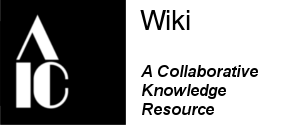Visible light imaging
Visible light imaging includes all the imaging techniques that use visible light (~ 400–750 nm) as primary radiation. Applications include: documentation before, during and after treatment; collection digitization; multiband or multispectral analysis; close-up documentation of details. Visible light imaging can be performed on two-dimensional and three-dimensional objects of different sizes and types, from small archaeological fragments to monumental mural paintings.
Different photographic setups can be used depending on the object’s scale and shape, as well as on the intended use of the images and the features that need to be documented.
Even illumination methods record the object’s appearance under standard conditions; raking light and specular illumination imaging help investigate the surface topography;[1] transmitted light imaging highlights the variation in density and thickness of a thin object and is used to digitize positive and negative film.
Safety considerations: prolonged exposure to strobe lights can pose risks for individuals with photosensitive epilepsy and may cause temporary visual discomfort or strain.
Even illumination[edit | edit source]
Even (or standard) illumination imaging techniques provide a record of the object under uniform light. Although the same principles of object photography apply, these techniques are most suited to record the appearance of the object in a reliable and standardized way, without introducing human subjectivity. Images produced with even illumination methods aim to document accurately the physical characteristics of the object at the time of capture, rather than their aesthetic.[2]
Different setups can be used depending on the dimensions, shape and materials of the object, as well as the available equipment and capture environment.
Raking light[edit | edit source]
Raking light is a simple but effective imaging technique in which a strong light source is directed across the surface of an artwork at a very shallow angle. This lighting condition exaggerates surface irregularities, casting high-contrast shadows that make features such as brushstrokes, creases, deformations, or past interventions more visible. It is particularly useful for studying the texture and topography of paintings, drawings, and relief surfaces, as well as for documenting planar distortions in supports such as canvas or paper. It is a widely used method for condition assessment, revealing details that are often not immediately visible under even illumination.
Specular illumination[edit | edit source]
Specular illumination is a technique used to document an object's reflective properties. The method intentionally captures and isolates the direct, mirror-like reflection of light to reveal subtle surface features like sheen, texture, and shallow indentations. Two setups can be used depending on the features that each disclose: an axial setup, where the camera and light source are on the same axis in front of the object, and an oblique setup, where they are on opposite sides at the same, narrow angle to the object’s surface.
Transmitted imaging[edit | edit source]
Transmitted imaging includes all those methods that consist of illuminating the object from the side opposite to the viewing position. In conservation imaging, this configuration allows to reveal the inner structure of the object by showing variations in density, thickness, paint losses, tears and previous repairs. Both visible light and infrared radiation are used, known as transillumination (or transmitted light) and transirradiation respectively.[3]
The technique is also used to digitize translucent objects, like film, glass photographic plates, stained glasses.
Further readings[edit | edit source]
Fisher, Lisa Jane. Photography for Archaeologists Part II: Artefact Recording. Vol. 26. British Archaeology Jobs and Resources, 2009.
Lisa Jayne Fisher’s guide provides a practical overview of best practices for professional, yet cost-effective, photography of archaeological artifacts. The digital publication contains a few layout mistakes, but the illustrations are often self-explanatory.
Frey, Franziska S, Jeffrey Warda, Dawn Heller, Dan Kushel, Timothy Vitale, Gawain Weaver, and American Institute For Conservation Of Historic And Artistic Works. Digital Photographic Documentation Task Force. The AIC Guide to Digital Photography and Conservation Documentation. 3rd ed. Washington, DC: American Institute for Conservation of Historic and Artistic Works, 2017.
An all-round publication that comprises recommendations for numerous imaging methods used in conservation practices.
Verhoeven, Geert. “Basics of Photography for Cultural Heritage Imaging.” In 3D Recording, Documentation and Management of Cultural Heritage, edited by Efstratios Stylianidis and Fabio Remondino, 127–251. Caithness: Whittles Publishing, 2016.
In this chapter, the author provides a comprehensive overview of the scientific and technical aspects of image formation, often delving into the physics involved in photography. Despite being fairly dated, this resource offers a solid starting point for those who approach imaging for cultural heritage documentation.
References[edit | edit source]
- ↑ MacBeth, Rhona. 2012. “The Technical Examination and Documentation of Easel Paintings.” In Conservation of Easel Paintings, edited by Joyce Hill Stoner and Rebecca Rushfield, 291–305. Routledge.
- ↑ Rieger, Thomas, Kristin A. Phelps, Hana Beckerle, Tanya Brown, Rachel Frederick, Sarah Mitrani, Patrick Breen, et al., eds. Technical Guidelines for Digitizing Cultural Heritage Materials. Federal Agencies Digital Guidelines Initiative, 2023.
- ↑ Cucci, Costanza, Marcello Picollo, and Muriel Vervat. “Trans-Illumination and Trans-Irradiation with Digital Cameras: Potentials and Limits of Two Imaging Techniques Used for the Diagnostic Investigation of Paintings.” Journal of Cultural Heritage 13, no. 1 (January 2012): 83–88.
| Browse by category | Community resources | Contributors' resources | Editors' shortcuts |
|---|---|---|---|
|
Community Portal |

